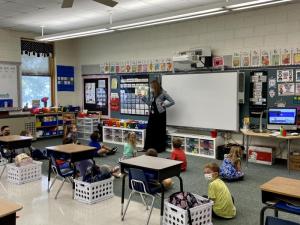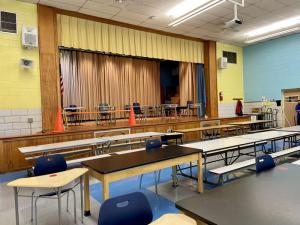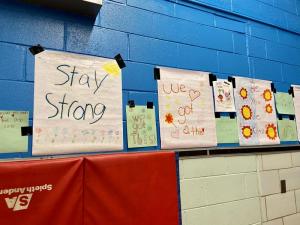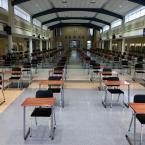Distancing, masks, technology curb COVID-19 in Cape schools
Just over five weeks into the 2020-21 school year, Cape district students and staff have settled into new routines and safety protocols necessary to stop the spread of COVID-19.
Health and safety measures are working, Assistant Superintendent Jenny Nauman said. As of Oct. 21, the district reported 10 total positive cases thus far among students and staff, none of which were linked to school.
“We have about 5,000 students and staff back in our schools,” Nauman said. “Teachers, parents and staff are doing the right thing, erring on the side of caution and using the daily self-assessment tool.”
Nauman said district officials originally thought enforcing mask-wearing would be a challenge.
“It’s been a non-issue; there have been no disciplinary actions with masks, and we know it’s one of the most important safety measures we can take,” she said.
Nauman said even the youngest students check each other, telling classmates to pull up masks that fall below their noses and to back off if they get too close.
“Kids are amazing, resilient and want to stay in school, so they’re doing what it takes,” Nauman said.
Procedures at each grade level
Elementary students attend either completely in person or remote. In-person students stay in the same classroom all day, except for lunch or gym, while teachers move between rooms, Nauman said.
As a social distancing reminder, Love Creek Principal Lisa Morris said, staff placed nearly 700 floor decals throughout the building, and spray-painted dots on sidewalks around school and the bus platform.
“Our students are true super troupers!” Morris said. “Students willingly wear their masks and social distance like trained soldiers. The younger students walk like mummies with their arms out in front of them to make sure they are not too close to the child in front of them.”
For lunch, students sit spread out in the classroom, in community pods outside each grade-level cluster, or in the cafeteria, where only 40 students can fit facing the same direction about eight feet apart, Morris said.
Parent drop-off and pickup procedures are working better than she imagined, Morris said; about 240 cars come to school each day.
“Our school resource officer comes daily to work the green light in the morning and afternoon to keep traffic flowing,” Morris said.
Parent Brian Cowell has a kindergartener and a second-grader attending Shields Elementary.
“Getting children back to school in person has been such a contentious topic, so I didn’t know what to expect,” he said. “It was emotional dropping my kids off, and seeing how enthusiastic teachers and staff were and continue to be. Public schools, not just private, can adjust to avoid unnecessary collateral damage and impacts on children that could have taken years to fix, if ever.”
Middle and high school students attend completely remote or hybrid. In the hybrid model, students are in school two days a week and work from home independently or via Zoom three days a week. Beginning Monday, Nov. 2, in-person Sussex Consortium students grade six through 21 years of age will attend four days a week.
“They’re our neediest population,” Nauman said.
Middle school students stay in one classroom while teachers change rooms. Students eat lunch in the gym or cafeteria in assigned seats to minimize exposure and aid contact tracing, if needed, Nauman said.
At Cape High, students move throughout school for classes, following directional arrows marked on the floor, Principal Nikki Miller said.
“For the most part, all halls are one-way,” Miller said. “We do have a small wing with little traffic that has to be two-way, but we have a barrier set up in the middle and arrows on the floor.”
For lunch, students sit in spaced-out desks in the cafeteria, Miller said.
“We wanted students to be able to still have freedom to sit where they wanted and not have to assign seats, so we divided the cafeteria into four zones,” Miller said.
Miller said students are asked to sit in the same zone every day. Once seated, they use their phone or iPad to scan a QR code at the corner of each desk.
“A Google form we created specifically for each zone pops up, and they enter their ID,” Miller said. “This way, if we need to do contact tracing, we check the Google document for the student ID on the days in question, and we can then easily review camera footage as well.”
Students are dismissed in waves spaced moments apart; wave 1 and 2 rooms are side-by-side, Miller said.
“That way, for example, if my room is wave 1, my neighboring classroom would be wave 2,” she said. “Between that and the one-way halls, it really spaces out students.”
To include all learners, Miller said, teachers adapt instruction, including English teacher Eileen Springfield, who partnered in-person students with remote students to summarize a story section.
“The partnerships collaborated to summarize their section on a Google Doc while zooming with each other in breakout rooms so they could discuss as they worked on the document,” Miller said. “Then, as a class, they came together and the partnerships presented to the whole class while virtual students were on Zoom.”
Teachers are moving instruction outdoors as much as possible, Miller said.
“Science teachers have been going outside for experiments; English teachers to go outside and read,” she said. “It has only been a month since we have been in-person learning, and we are so incredibly proud of our teachers. This is very difficult work even for our most experienced teachers.”
Enhanced cleaning procedures
Nauman said each school building's chief custodian developed a specific cleaning plan.
“Our custodial crew has worked the whole time since March and stepped up to make sure everyone is safe,” Nauman said.
Supervisor of Facilities Lenny Richardson said custodians are accustomed to cleaning touch points multiple times a day during flu season.
“This obviously has increased even more with current conditions,” Richardson said.
Custodians schedule cleaning when students leave the classroom for specials such as gym, art, or lunch.
“That is when they are able to go into classrooms to clean touch points,” Richardson said. “We definitely have the assistance of teachers, paraprofessionals, service aides and students performing these tasks as well. It really has been a team effort to make things work.”
Richardson said custodians are using backpack sprayers to disinfect large areas at each school. Cleaning supplies are on the EPA-approved list and were used pre-COVID as well, he said.
Nauman said district officials negotiated with the teachers union to limit times teachers can be in schools to streamline cleaning. Previously allowed in schools from 5 a.m. to 11 p.m., seven days a week, teachers are now permitted in schools from 6 a.m. to 6 p.m., Monday through Friday, and they can’t bring outsiders with them.
Model for other districts
Cape is one of a handful of Delaware districts that opened under a hybrid model of instruction in which students attend fully remote, in person or a mixture of the two.
Nauman said a team comprising school and public health officials from Cecil County, Md., recently visited Cape schools at each level to ask about social distancing, scheduling, instruction and lunch procedures as they develop their own reopening plans.
“We get calls daily from other school districts in Delaware as they try to reopen now,” Nauman said. “Every press conference, the governor mentions us and says he’s thankful for what we’re doing. There’s no reward without taking a chance, and our hard work has paid off.”
































































